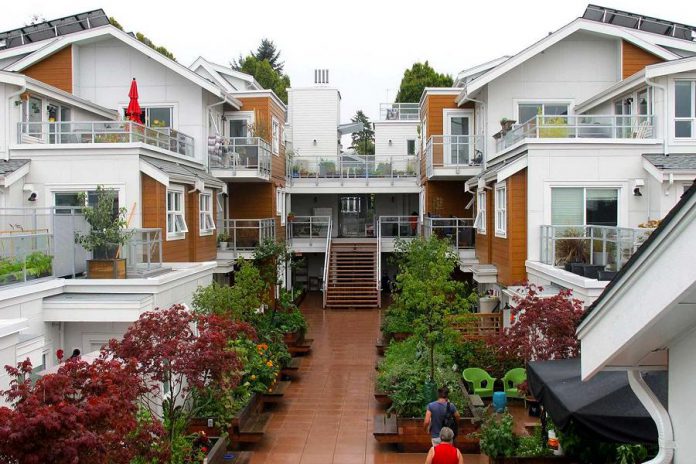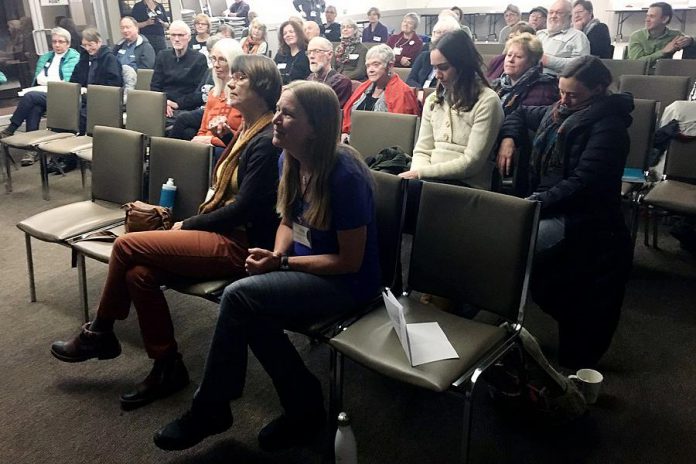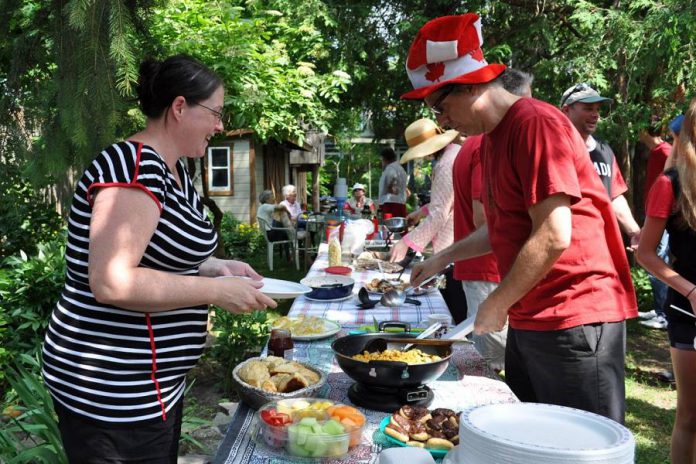
Back in the 1960s and early 1970s, communal living espoused and practised by the members of the hippie subculture was as criticized as it was misunderstood.
Still, one basic tenet of communal living — the sharing of property, possessions, and resources to the benefit of all — was tough to argue with.
Now, decades later, a growing worldwide interest in the benefits of cohousing, and the resulting establishment of a number of cohousing communities, has at its centre (you guessed it) the sharing of property, possessions, and resources to the benefit of all.
On Wednesday night (March 6), members of Peterborough-based cohousing group Kawartha Commons came together at the Lions Community Centre to provide an update on its efforts to develop a 10 to 30 unit cohousing community in or near the city by 2023.
According to the group’s website, cohousing is a mutually supportive but independent living-based custom-built neighbourhood that sees people design, build, and manage housing for themselves in a village-like setting.
Similar to condominium living in that it features small living units — in the form of detached homes or apartments — cohousing is based on the concept of an “intentional community” that has at its centre shared resources, including a common house with a kitchen and dining room for regular shared meals that residents participate in as desired.

While co-housing residents typically own their living spaces, each is involved in the planning, design, management and ongoing maintenance of the community.
“Cohousing appeals to people willing to give up a little bit of the things they claim ownership to in order to share with others,” says Kawartha Commons member Scott Donovan, an architect who served a work term in 2013 with a Massachusetts firm with a specialty in cohousing development.
“You have to also be willing to participate in community; to give of yourself in volunteer time, in organizational time. We know the rewards are great. There’s social support, there’s the development of friendships, and there’s the sharing of challenges that come up.
“We live in a society that’s based on the expression “Every man is an island.’ Cohousing is radical. It cuts across that and illuminates the good that we can do together as a group. I think there’s something really primal about that … the tribe mentality, people sticking together. It’s powerful.”
Upon his return to Peterborough from Massachusetts, Donovan was approached by Al and Linda Slavin who had done their own research on cohousing. That led to a late December 2017 get-together at their home that attracted close to 30 people and led to the formal establishment of Kawartha Commons. Many of those same people — who Donovan credits with “moving the needle forward” — were at Wednesday’s gathering.
“It takes meetings, meetings, and meetings,” laughs Donovan, when asked what needs to happen to make Peterborough’s first planned cohousing community a reality.
“And it takes education and awareness … illuminating the public to the possibilities of cohousing. It takes building relationships. The premise of cohousing is it’s a social movement involving a group of people who want to build housing in a social atmosphere.

“But it’s important we get to know one another first. It’s about finding your tribe. It’s about connecting with a small group of people and feeling ‘I can do this with you.’ We’re going to be sharing a community so it’s important we’re on a similar level. It’s about trust.”
The cohousing concept came to North America in 1988 from Denmark where, in 1967, a newspaper article headlined ‘Children Should Have 100 Parents’ spurred a group of 50 parents to organize a community project from which the first known modern cohousing development sprang.
Since then, some 160 cohousing communities have been developed and inhabited across North America, including two in Ontario (Terra Firma in central Ottawa which was begun in 1997 and Whole Village developed near Caledon in 2006).
More than 100 cohousing projects are also in various stages of development, including six in Ontario: Canopy in Toronto, Concorde Cohousing and Convivium Cohousing for Seniors in Ottawa, Sweetfurn Cohousing in Sudbury, Tay Commons Cohousing in Perth, and Waterloo Region Cohousing Project in Kitchener.
The Canadian Cohousing Network, formed in 1992 in British Columbia, is a registered non-for-profit organization that promotes the creation of cohousing communities as a model for sustainable development by raising public awareness about cohousing and by bringing people together to form communities.
During Wednesday’s meeting, the term ‘sociocracy’ — a system of governance that seeks to achieve solutions that create harmonious social environments — came up more than once. Applied to the cohousing model, that sees decisions affecting the community determined by group consensus. However, in her comments, Kawartha Commons member Jill Jones summed up what’s really at the heart of cohousing success: “People know and care about each other.”
Jones added the cohousing model has several proven benefits, including the saving of land as a result of clustered housing, less consumption of renewable resources as a result of sharing, and living spaces that face common areas, promoting interaction as a result. Also, because parking is located at the periphery of a cohousing development, that encourages interaction with others as residents walk to and from their vehicles.
Several Kawartha Commons members have visited cohousing communities across North America to learn more, including a trek last spring to Whole Village. Just this past January, a dozen members attended Getting It Built, a cohousing information session held in Toronto.

The Kawartha Commons group now has 33 full and associate members, each of whom pay a membership and have committed fully to the process moving forward.
According to Bill Slavin, the group is now actively looking at potential sites, including a 3.2 acre property off Romaine Street just west of Park Street.
The cost of a home or apartment unit, added Slavin, is about the same as that for a detached townhouse, in the $350,000 to $400,000 range. That said, he notes there are significant “trade-offs” such as fewer monthly operating expenses and, for those who share vehicles or car pool, fewer vehicle-related costs.
“It’s realistic for cohousing communities to be successful in five years,” note Donovan, in reference to the group’s ambitious goal of developing a Peterborough cohousing community by 2023.
“It isn’t easy, but it’s realistic. It can take a year and a half to have a set of building plans. There’s an enormous amount of work in developing the group and make it work. We’re about to hire a consultant, the expert on cohousing in North America. That is significant. We need to incorporate so we’re shareholders in the corporation.”
For more information about Kawartha Commons, visit the group’s website at www.kawarthacommons.ca or Facebook page.
For more information about the Canadian Cohousing Network, visit cohousing.ca.


























